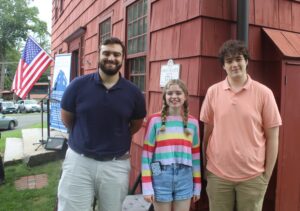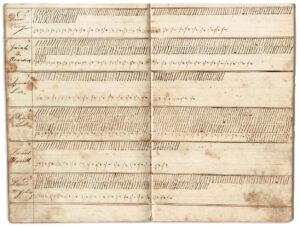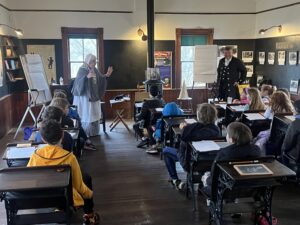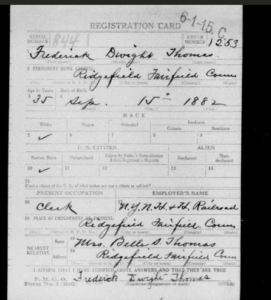The ‘New’ Ridgefield High School at 50:
A Half-Century Since a Great Ridgefield Debate — and a resolution that depended on 63 votes
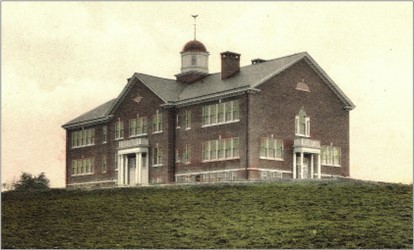
This fall marks the 50th anniversary of the opening of what is still to some the “new” Ridgefield High School. The “old high school” on East Ridge is now home to the Ridgefield Playhouse, Chef’s Warehouse, and several town agencies — all part of the Richard E. Venus Municipal Complex.
Recently arrived Ridgefielders might reasonably wonder about the location of the high school, in a residential area near the New York State line and far from the village. The decision to place it there was not an easy one back in the late 1960s, when a burgeoning school population led to overcrowding at the town’s high school on East Ridge, which was originally opened in 1915 as the Benjamin Franklin Grammar School. [The town’s first high school, the Alexander Hamilton High School, also opened in 1915, using the former Center School on Bailey Avenue to create the four-room high school (a fifth room was later added).]
The big brick building on East Ridge with its high-ceilinged classrooms was the beginning of the modern school era in Ridgefield and the culmination of a campaign that had begun at the turn of the century. Townspeople had privately raised money toward building the new school, finally leading the annual town meeting to agree to an appropriation of $40,000 for the project (about $1.2 million today).
Historian George L. Rockwell described the town’s embrace of the new school: “On July 4th, 1914, the corner stone of the new school building was laid with imposing ceremonies. Honorable Howell Cheney of Manchester gave the address of the day. The day was given over to festivities, a parade being held, and in the evening the Ridgefield Band gave a concert, which was followed by a display of fire-works.”
In the years before Alexander Hamilton High School was opened, any Ridgefielder who wished to pursue education beyond the eighth grade was obliged to go by train to Danbury or Norwalk, where there were public high schools, or attend private classes such as those offered by the Nash Private School on Main Street.
(The reason for the Board of Education’s choice of the name Alexander Hamilton High School went unrecorded, but the Board of Education did make it a policy in later years not to name schools for persons. Rockwell merely recorded the fact that it was so named at the same time as the new East Ridge school opened as the Benjamin Franklin Grammar School. When the high school moved to East Ridge after an addition had been built in 1926, it became known as Ridgefield High School, beginning in 1927. Grades K-1 took over the Bailey Avenue building, as The Garden School.)
The town’s population grew and the high school expanded, with grades moving in and then out of the East Ridge building as the last of the district schools closed. It had become exclusively a high school by 1968, with further additions and a new junior high school and new elementary schools (Veterans Park, Ridgebury, Farmingville) to absorb the younger grades, as the population of Ridgefield burgeoned to 18,000 by 1970.
With the high school enrollment expected to continue to grow rapidly, the town had set in
motion planning for a new high school, to be built on 50 acres of the town-owned property, formerly owned by the late Miss Anne S. Richardson. The High School Building Committee, headed by John P. Cooke, spent two years working with Fletcher-Thompson Inc. to draw up plans for the North Salem Road school. When the plans went out to bid in early 1969, the rampant inflation of the time raised the cost, from the original appropriation of $6.5 million in July 1968, to nearly $9 million.
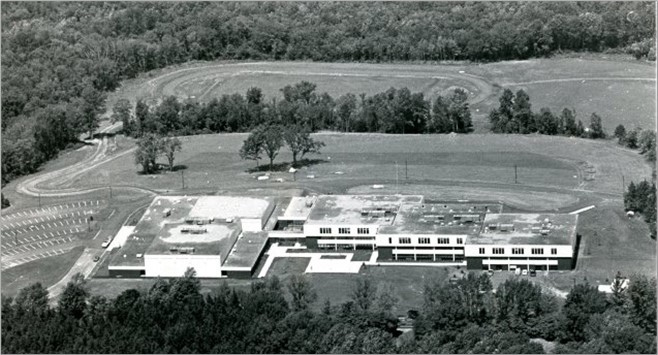
Opposition arose quickly and those against the “Richardson” plan proposed building on East Ridge as a less-expensive option. The selectmen appointed an East Ridge Study Committee and hired The Architects Collaborative of Cambridge (TAC), Mass., to come up with suggestions.
The report TAC produced recommended building a 1,400-student addition to the existing 650-student school, which would be renovated. The report argued that the school would be in the center of town and less expensive than the alternative.
Even though the Superintendent of Schools Dr. David E. Weingast had voiced his favor for the “Ridge” proposal, the Board of Education was unmoved and voted 7-2 in September to continue with the plan for the Richardson property. Questions of costs (“Ridge” proponents argued theirs was the less expensive option) and school overcrowding caused by a delay to draw up new plans (the fear of the “Richardson” supporters) were debated well into the fall.
Finally, on Oct. 18, 1969, a referendum took place to decide whether to rescind the $6.5-million appropriation already approved. So “yes” meant a vote against the Richardson plan and “no” meant yes to it.
By a margin of 63 votes, Ridgefielders declined to rescind the money for the Richardson plan and the project went out to bid; on Nov. 28, Bonvincini Inc. of Torrington came in with a low bid of $7,127,000. The following January, a town meeting passed an additional appropriation of $2.6 million and the High School Building Committee correctly predicted a September 1972 opening.
This project was five years in the making, beginning in 1967 when the school administration spent a year drawing up specifications for the new school. The Board of Education then reviewed and modified these proposals, a task that occupied many meetings led by Chairman Allen O. Shafer, with members Enzo Bartolucci, Dr. Joseph Belsky, Robert S. Haight, Dr. Charles P. Izzo, Mrs. Lodi Kysor, Thomas E. Nelson, Paul R. McDevitt and Dr. Richard Scala. Also serving during the 1967-72 period were Dr. Clifford W. Smith, Frank D. Salamon, J. Edward Hall, David D. Huntoon and Horace G. McDonnell. As the school opened, the board consisted of Chairman Lodi Kysor, A. Raymond Bessette, Samuel DiMuzio, Leo F. Carroll, Mary Gelfman, Sam Palasciano, Stanley Kullbom, Dr. Stanley Gianzero, and Dr. Richard Scala.
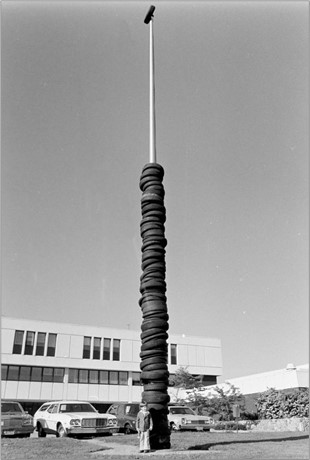
One of the questions that arose in the planning of the new school was whether the ninth grade should be moved from the junior high to the senior high school. James. M. Blackwell led a Ninth Grade Placement Committee, which recommended to the board that a four-year program be established; the board agreed. Principal Dr. Harold E. Healy would have four grades under his leadership at the new school and the eventual RHS Class of 1975 would be the first graduating class to not have the “old high school” experience, going from 9th grade at East Ridge Junior High School to starting 10th grade at the “new high school.” (East Ridge Junior High remained a two-grade school, 7th and 8th, until it was converted to East Ridge Middle School for grades six to eight in 1986.
John P. Cooke devoted six years to the “new high school” and led a committee of Ridgefielders who proudly turned over the school to the town, on time and on budget. In a special supplement to The Ridgefield Press published on Sept. 14, 1972, Mr. Cooke wrote, “It is an exciting and awesome accomplishment. It should bring a vitality and drive to the education programs which the educators have designed. We hope that it meets their objectives and becomes an effective part of the educational system.”
He noted, “According to available statistics concerning school construction contracts awarded at the time, the new Ridgefield High School is the least expensive project of its kind. This is due in large measure to the professional abilities of the architects and engineers of Fletcher-Thompson, Inc. They also deserve credit for the building’s strong architectural statement which affirms the solidity of this Connecticut town and blends with, rather than overpowering, its setting.”
Serving with Mr. Cooke on that building committee were Enzo Bartolucci, John DioGuardi, Samuel DiMuzio, Lodi Kysor, Charles Weitzel Jr., Dr. Philip Martin, John Sturges, and Robert Mannion, the committee secretary. Three first selectmen held office during the more than five years that the
committee did its work: Leo Carroll, J. Mortimer Woodcock and Joseph McLinden.
On opening day in 1972, there were 1,725 students.
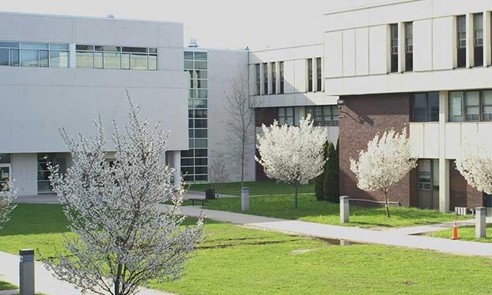
In the years since the school opened there have been notable additions to the building and campus, including the Tiger Hollow Stadium complex, which opened in 2001, and the soaring student center, built in 2002. The Scotts Ridge Middle School opened next door in 2002 on land that had also once been owned by Anne S. Richardson.
Josie Hoyt’s Words Preserve Ridgefield History
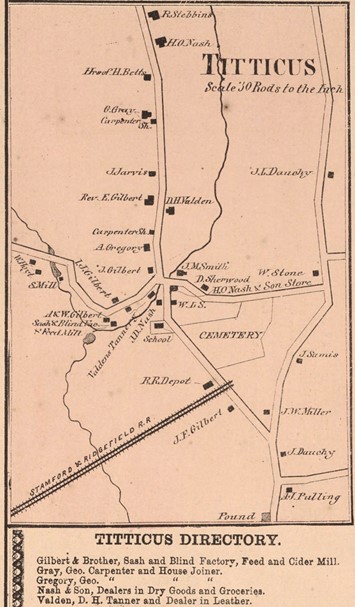
On the shelves of the Ridgefield Historical Society’s library in the Scott House, are two volumes that offer a window into life in Ridgefield during the late 19th Century, and more specifically into Josephine Myrtle Hoyt Wright’s long life. One contains transcriptions of three diaries (plus additional notes) and the other, titled All Through the Years, is a memoir written in 1942 by Mrs. Wright for her two sons.
Josie Hoyt was born in 1872 when the losses of the Civil War were fresh; she died at the start of the turbulent 1960s. A descendant of early Ridgefield settlers, she began her life here when Ridgefield was just becoming a destination for a wealthier set. Her family lived in Croton Falls, N.Y., when she was born but soon moved back to the Titicus District in Ridgefield where her father had grown up.
As shown by her diaries, Josie was a lively and observant child and her memoir written late in life suggests she had a good memory for detail. Her diary entries always start with the weather, and usually include references to food and reports on family travel, work in the house and school attendance.
Josie was 13 when her “Papa” gave her a diary as a New Year’s present. Her first entry of 1885 Thursday, Jan. 1, read: “Damp and foggy. Ma is making doughnuts. Grace [her youngest sister, born April 19, 1883] is very cunning. Pa went to meeting [church] tonight. He got the sunday school books. Carrie is at Birmingham [an early name for part of Derby, CT]. Richard, Jennie and Earnie is coming down Saturday.”
A 19th Century diary written by a 13-year-old might not seem like a terribly valuable piece of history; its entries could be considered mundane, not very exciting, certainly not as interesting as a contemporaneous account of the Battle of Ridgefield.
But throughout the entries are scattered nuggets of important Ridgefield history and occasional insights into those events: births and deaths, arrivals and departures, escapades at the Titicus School, the Blizzard of 1888, even a possible murder-suicide.
The latter involved Dr. Archibald Y. Paddock, a dentist who’d treated members of the Hoyt family. Josie’s diary record was: “Dr. Paddock shot his son Harry while they were shooting at mark [target shooting]; shot him four times with a pistol, then took a shotgun and killed himself. Whether he was insane or not, people do not know. It is a mystery. Sam Dauchy saw it all. Mrs. Paddock and daughter feel awfully. The funeral is today. They buried the gun in Dr. Paddock’s grave. There were flowers on the boy’s grave, but none on Dr.’s.”
Life could be dangerous in many ways in the late 19th Century and Josie recorded the illnesses, injuries and deaths of relatives and friends matter-of-factly. On Sunday, March 15, 1885, she wrote: “Charles Hoyt got kicked by Deacon Benedict’s horse yesterday; very bad it is.” (Mr. Hoyt apparently survived his encounter and lived till 1926.) Just a month later, on April 13, the horse was at it again: “Deacon Benedict’s brother got kicked very badly with Deacon’s horse and the doctor says he can not live.” (The brother died that night. Josie did not mention what happened to the horse. On Oct. 5, she recorded that Mr. Abbott was “quite sick. The horse kicked him.” Whose horse, she didn’t say.)
Josie tells little specific about her education at the Titicus School, although she does share daily detail of an ongoing academic competition that she eventually wins (one of her competitors is her neighbor and friend, Howard Nash, younger brother of Luther Nash, on whom Josie seems to have a schoolgirl crush).
The teacher in 1887, a Mr. Thompson, is a problem, for the students and no doubt for the district school committee. On May 11, Josie writes: “Mr. Thompson tried to teach school this morning but was too intoxicated to do so.” On May 12, “There is no school today.” That fall, on Oct. 3, Josie reports, “Thompson has been on an awful tare up this week. Marion Nash teaches now.” (Marion Nash, later librarian at the Ridgefield Library, was a neighbor of the Hoyts in Titicus; her father, John D. Nash, owned the store there.)
JOSIE’S FAMILY
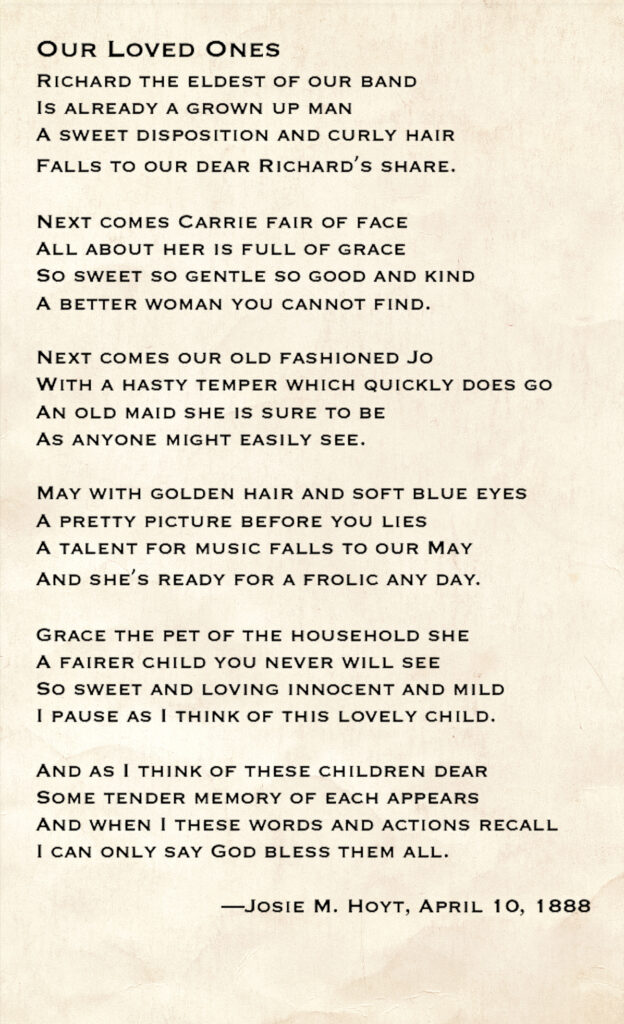
The Hoyts’ social activities revolved around family and their church, the Methodist Episcopal Church (now Jesse Lee Memorial United Methodist Church). By the time of the diary, the Methodists were in their third church building, at Main and Catoonah Streets.
Josie was one of nine children, the seventh born to Elias Gilbert and Martha Ann (Lessey) Hoyt. Her father’s family came from South Salem, N.Y., with roots in Ridgefield and branches in both communities; her mother was from New Fairfield. Elias and Martha lived in Croton Falls, N.Y., where other family members were established, from 1855 to 1870, before moving to Ridgefield where Elias continued to work as a carriage-maker. Four of Josie’s siblings died at early ages: Clara, just weeks old, in 1858; Eva, two months old, in 1860; and Chauncey, seven, and Addie, not quite two, both of scarlet fever, in March 1870.
In Josie’s youth, the family doctor was available but still had nothing in his arsenal to combat many of the diseases that claimed young lives, like scarlet fever and diphtheria. Josie reports these diseases as well as relatives suffering from food poisoning and various respiratory diseases and even malaria, but the most common affliction that she records is “the toothache.” The typical remedy: having the local dentist or doctor pull the offending tooth.
With a considerably older brother Richard, born in 1856, and sister, Carrie, born in 1864, Josie was especially close to her sister Cornelia May, known as “May,” just three years younger. Grace, the baby of the family, was 11 years younger than Josie.
HOLIDAYS

What might have been a typical Ridgefield family’s Thanksgiving meal in 1885? (The national holiday was established by President Abraham Lincoln’s 1863 Proclamation that Thanksgiving be regularly commemorated each year on the last Thursday of November.) In 1885, relatives joined the Hoyts for dinner which included “stuffed chicken and chicken pie and potatoes, pumpkin pie, peach pie, rice pudding, turnips, sauce, beets, onions and other things” (not necessarily in the order recounted by Josie).
Josie’s entry on Dec. 25 in 1885 is brief: “Clear. Today is Christmas; we all went over to cousin Mary’s today. I stayed all night. I got a work box, candy, tooth powder, and three new irons at home and Lulu gave me a fancy work basket and Nell a suit bag.”
The following day, a Saturday, Josie reports other gifts: “Clear. Lulu, Edith and Carrie have been over here today. I got, down to the church, a book by the name of Little Women by L.M. Alcott; it is very interesting….”
[Little Women by Louisa May Alcott was published in 1868-69 and was wildly popular; the author was still living when Josie received this book.]
In June, Josie added to her Alcott collection: her June 15 diary entry reported that school was out for the summer. “I got two prizes — an ink stand and a book by Louisa M. Alcott.”
Other holidays that Josie mentions in her diaries include Valentine’s Day (receiving a Valentine was a special event), Easter, Decoration Day, and the Fourth of July (there were fireworks).
A YEAR OF TRANSITION
The last year of Josie’s diaries, 1888, is a year of transition, as her schooling ends and she begins to learn to be a telegrapher, taught by Mrs. George Johnson, the station agent’s wife.
“Well, I have begun today [Oct. 8] to learn telegraphy of Mrs. George Johnson. I am to pay 25 cents a lesson and take two lessons a week and practice every day. Oh! I hope I can learn; I am so glad. I like Mrs. J very much.”
The year 1888 was an exciting one for the Hoyts, as Elias Hoyt was elected to be a state representative for Ridgefield. On Nov. 13, Josie writes, “The people came up to serenade Pa — came about 7:30, stayed until after ten. We had chocolate, raisin, coconut [cakes], ginger snaps, sugar cookies and jumbles with chocolate and white icing; also sandwiches and cheese and coffee. The boys came from down town after the rest had got through eating, they shot off the cannon five or six times. They came in the kitchen and we passed around stuff. Pa passed cigars. Then they cheered for [the also-elected U.S. President Benjamin] Harrison and Pa. Then they all sang, then the boys went out and fired off the cannon some more.”
Mr. Hoyt served his town in many capacities; he died in 1902 at the family homestead in Titicus.
Josie went on to a career as a telegrapher, working for four years in the Newtown train station where she handled Western Union messages as well as train orders. She enjoyed the challenges of the job as well as dealing with the town’s switchboard. On one occasion, she was able to avert a wreck on the main line by alerting six men on a handcar that a “wild engine” was coming through. In her memoir, she says, “Always those six men made the sign of the cross whenever they saw me and nothing was too good. I only did my duty, though the paper said I was a heroine.”
When she was 22, Josie married Frank Wright at Jesse Lee Memorial Church in Ridgefield, the first bride to be wed in the rebuilt church, with its new stained glass windows and a new organ. The ceremony took place on Oct. 30, 1894 and the young bride looked ahead: “All that I had hoped for was to be mine — Love, home, children and happiness. All through the years!”
There is much more to the story of Josephine Myrtle Hoyt Wright and her family, including her extensive genealogical research. Family histories such as hers are a treasure to be preserved but also to be studied and shared at the Ridgefield Historical Society.
The Scott House Journal (SHJ) is a quarterly publication, sharing stories of Ridgefield past. It is written by Sally Sanders, Historical Society Board member and former arts editor for the Hersam Acorn Newspapers.


